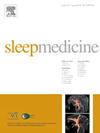Long term noninvasive respiratory support in children with OSA-I and OSA-II: Data of a nation-wide study
IF 3.8
2区 医学
Q1 CLINICAL NEUROLOGY
引用次数: 0
Abstract
Purpose
The aim of the study was to analyze the characteristics of otherwise healthy children with obstructive sleep apnea (OSA; OSA-I) and children with OSA and non-syndromic obesity (OSA-II) treated with long term continuous positive airway pressure (CPAP) or noninvasive ventilation (NIV) in 2019 in France.
Methods
Data were collected from a national survey on paediatric home noninvasive ventilatory support. CPAP/NIV initiation criteria and duration, age at CPAP/NIV initiation, equipment used and CPAP/NIV settings, and objective compliance were analyzed.
Results
Patients with OSA-I and OSA-II represented 6 % (n = 84, 71 % males) and 10 % (n = 144, 72 % males) of the national cohort, respectively. The apnea-hypopnea index (63 % vs 76 %), alone or combined with nocturnal gas exchange (25 % vs 21 %, for OSA-II and OSA-I patients respectively) were used as initiation criteria of CPAP/NIV. OSA-II patients were older at CPAP/NIV initiation (mean age 11.0 ± 4.0 vs 6.8 ± 4.5 years, p < 0.001) and were treated for a longer time (2.3 ± 2.6 vs 1.3 ± 1.5 years, p = 0.008) than OSA-I patients. NIV was used in 6 % of OSA-I patients and 13 % of OSA-II patients (p = 0.142). Both groups used preferentially a nasal mask. Mean CPAP level was higher in OSA-II patients as compared to OSA-I patients (8.7 ± 2.0 vs 7.7 ± 2.4 cmH2O, p = 0.02). Objective compliance was comparable (mean use 6.8 ± 2.6 vs 5.9 ± 3.0 h/night in OSA-I and OSA-II, respectively, p = 0.054).
Conclusion
Six and 10 % of children treated with long term CPAP/NIV in France in 2019 had OSA-I and OSA-II, respectively. Both groups were preferentially treated with CPAP and were comparable except for age, with OSA-II patients being older at CPAP/NIV initiation.
OSA-I和OSA-II患儿的长期无创呼吸支持:一项全国性研究的数据
目的:本研究的目的是分析其他健康的阻塞性睡眠呼吸暂停(OSA)儿童的特征;2019年,在法国,OSA- i型和OSA- ii型儿童接受长期持续气道正压通气(CPAP)或无创通气(NIV)治疗。方法:收集全国儿童家庭无创通气支持调查数据。分析CPAP/NIV启动标准和持续时间、CPAP/NIV启动时的年龄、使用的设备和CPAP/NIV设置以及客观依从性。结果:osa - 1和OSA-II患者分别占全国队列的6% (n = 84,男性71%)和10% (n = 144,男性72%)。呼吸暂停-低通气指数(63% vs 76%),单独或联合夜间气体交换(分别为25% vs 21%, OSA-II和OSA-I患者)被用作CPAP/NIV的起始标准。OSA-II型患者在CPAP/NIV启动时年龄较大(平均年龄11.0±4.0岁vs 6.8±4.5岁,p 2O, p = 0.02)。客观依从性具有可比性(OSA-I和OSA-II患者的平均使用时间分别为6.8±2.6和5.9±3.0小时/晚,p = 0.054)。结论:2019年法国接受长期CPAP/NIV治疗的儿童中,分别有6%和10%患有OSA-I和OSA-II。两组均优先接受CPAP治疗,除年龄外具有可比性,OSA-II患者在CPAP/NIV开始时年龄较大。
本文章由计算机程序翻译,如有差异,请以英文原文为准。
求助全文
约1分钟内获得全文
求助全文
来源期刊

Sleep medicine
医学-临床神经学
CiteScore
8.40
自引率
6.20%
发文量
1060
审稿时长
49 days
期刊介绍:
Sleep Medicine aims to be a journal no one involved in clinical sleep medicine can do without.
A journal primarily focussing on the human aspects of sleep, integrating the various disciplines that are involved in sleep medicine: neurology, clinical neurophysiology, internal medicine (particularly pulmonology and cardiology), psychology, psychiatry, sleep technology, pediatrics, neurosurgery, otorhinolaryngology, and dentistry.
The journal publishes the following types of articles: Reviews (also intended as a way to bridge the gap between basic sleep research and clinical relevance); Original Research Articles; Full-length articles; Brief communications; Controversies; Case reports; Letters to the Editor; Journal search and commentaries; Book reviews; Meeting announcements; Listing of relevant organisations plus web sites.
 求助内容:
求助内容: 应助结果提醒方式:
应助结果提醒方式:


